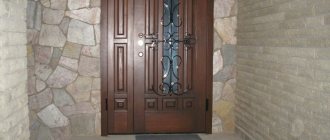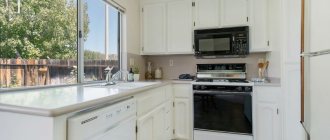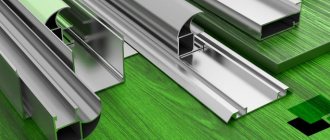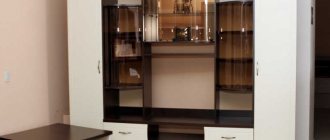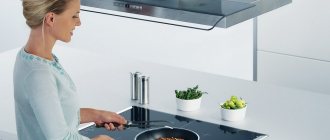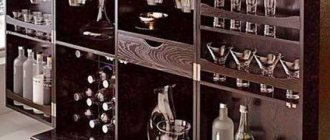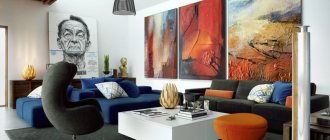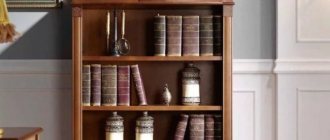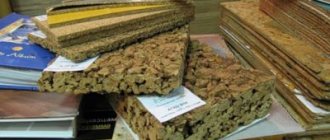What is eco-veneer?
So, what is eco-veneer made from ? – There are many versions about this on the Internet. The most common is wood fibers or sawdust in resin or polymer, all of this is pressed and rolled into a film. Probably material with such a composition exists in principle, but is not used in Russia. In our country, eco-veneer is considered to be polypropylene film with wood-like decor.
But in fact, under the “eco-veneer” label, we sell doors with three types of coatings:
- Cheap finishing film: These are the same laminated paper doors with a very low cost, usually drawer-sided in design and very similar to real eco-veneer ones. They are passed off as real only by irresponsible manufacturers and sellers;
Polypropylene films are durable, thick, safe for health, like a polypropylene medical container;
PVC films – this also happens. To diversify the assortment and offer the consumer completely new “wood-look” doors, there is no need to buy new equipment - nothing needs to be changed except the name. And what’s interesting is that there seems to be nothing to blame the manufacturer for, since there are no fundamental differences to be found in the properties of PP and PVC. Polymers are in a sense interchangeable, with the exception of some details, but more on those later.
Why did it even occur to sellers to pass off doors with cheap finishing films as eco-veneered? In short: polypropylene films and cheap finishing films can be applied to doors using the same equipment. Those. a manufacturer, without changing machines, simply by selecting other modes, can enter a higher segment where PVC dominated. Tsar doors did particularly well, due to their more modern design and lack of edges. Despite the fact that polypropylene film is slightly more expensive than PVC, in general, the costs are low, and the products can be sold at 1.5 - 2 times more expensive. Over time, side doors coated with eco-veneer became so popular that strong competition began among these models and began to attract prices. This is where very inexpensive side doors appeared on the market, like those with eco-veneer, actually with a cheap finishing film.
Eco-veneer is in fashion. Why, doors with such a coating are simply wildly popular. The leader in the middle price segment, which PVC was previously considered to be, had to make room. The most interesting thing is that people don’t really want to understand the similarities and differences of materials, the cause-and-effect relationships, which, by the way, are the same here:
- The reason is a bright advertisement of a new product with a hypnotizing prefix “eco”, which acts on the subconscious like a pipe on a boa constrictor;
The consequence is high demand among consumers with average incomes, who are the majority.
How it works? One of the options. You came to the store and still don’t know about the existence of doors coated with eco-veneer. You need a door that costs about 3 - 5 thousand rubles. The consultant takes you to the department with the cheapest laminated doors. You observe their frankly cheap appearance, and the seller says that they are short-lived, are afraid of moisture, etc. Accordingly, after this, move on to PVC structures, the consultant talks about their water resistance, quality, beauty, and ease of maintenance. If he sees that the buyer has doubts about the choice (he doesn’t like the rustic design, the surface doesn’t look very similar to natural veneer), all that remains is to put the squeeze on him. This is easy to do, because on the contrary, they are safe, very beautiful doors made from natural wood. An environmentally friendly product without chlorine, it costs little, is durable, and has a modern drawstring design. None of the guests can believe that this is also an ordinary film, albeit polypropylene, because the coating is so similar to natural veneer. It's hard not to give in to temptation, isn't it?
Is PVC film really unsafe? It's time to put an end to the legend of PVC toxicity once and for all. To do this, you do not need to conduct special experiments - just remember the school course in inorganic chemistry. Chlorine gas is known to be poisonous. It is part of PVC, which is determined by its name. However, in the polymer it is used in a bound form and is vinyl chloride. There are a lot of such safe chlorides in our everyday life. For example, sodium chloride, or regular table salt. If chlorine were used in the above-mentioned formulations in its pure form, it would look like the popular “Belizna” cleaner: there is about 95% chlorine, it is incredibly toxic and emits a terrible odor.
Therefore, the environmental friendliness of PP compared to PVC is a myth. Another thing is the compositions with which they are coated, or rather, with the help of which the decor is made on the surface of both films. So, these dyes, fixatives, etc. may contain resins based on formaldehyde, methanol - components harmful to humans and nature. Remember how new linoleum, a Chinese inflatable pool or rubber Crocs phonate when the item is new or the surface heats up under the influence of sunlight. The smell indicates the use of a dangerous, low quality additive. It is better to get rid of such a product, including doors.
At the same time, the quality of the decor determines how PVC and polypropylene (eco-veneer) look. How similar are they to natural wood or other natural materials? It is the quality of the decor that explains why one film conveys all the nuances of a wooden surface so well, while the other looks cheap. Polypropylene is a relatively new facing material; it is made using modern equipment and its decor is often better than that of inexpensive PVC film. This is precisely what explains the emergence of such a powerful, from a marketing point of view, association with natural veneer.
Conclusion: eco-veneer is polypropylene. It is slightly more expensive than PVC and requires different equipment to apply to the workpiece. Both materials are waterproof, produced with matte and glossy textures, the degree of resemblance to natural wood depends on the quality of the decor.
Eco-veneer production technology
Eco-veneer is made from natural wood fibers obtained from waste from the wood processing industry. According to the manufacturing technology, the fibers are carefully prepared, dyed, mixed and joined together using polymer glue.
The semi-finished product obtained in this way goes under the press, where, under the influence of gradually increasing pressure, it acquires its final characteristics. Eco-veneer, completely ready for use, is a thin sheet material that is rolled into rolls for ease of storage and transportation.
How to choose high-quality doors coated with eco-veneer?
If you read the previous chapter, you are probably puzzled how to distinguish one coating from another, because in the store all the doors seem the same?
The surest remedy is to study the upper end part of the canvas. It remains invisible, so it is not covered with decorative films. Everything is visible here - frame materials, finishing, as well as their thickness. What is in front of you, laminate or polypropylene - try to lightly pull the edge of the film. Laminate flooring is made from cellulose. It is not plastic, so it will tear like paper, unlike eco-veneer, which stretches.
If you are convinced that the sample is indeed film and not paper, what next? How to determine quality? It's simple, firstly, the thicker, the better and stronger. Secondly, pay attention to the decor. It should be clear and not a copy of a copy. You should like it, its relief, shades, everything should be similar to the natural original.
Now about construction materials. Inexpensive ones go into production:
- Solid pine - to strengthen the load-bearing parts of the door leaf;
LVL timber, in our opinion laminated plywood, is used for the same thing as pine timber, only in more expensive models. It is stronger than pine timber and less responsive to changes in humidity;
MDF panels are the most popular material in the door industry. All doors that are not 100% solid wood contain MDF in their construction. It is durable, cheap, and does not change its geometry depending on external conditions. Therefore, it is an ideal base (substrate) for an external decorative layer, no matter what: all kinds of films, natural veneer, enamel. If you apply the coating directly to solid pine, nothing good will come of it - the veneer and enamel will crack, the film will peel off. Well, wrapping doors made of noble solid wood (resistant to everything) with cheap film or something else is not profitable, not to say absurd.
High-quality doors should be durable and have good sound insulation. If the manufacturer saved money, then there are many cavities inside the elements of the canvas that can be filled with corrugated cardboard. The more of these cavities, the lighter the door. Also, it is simply necessary that the door is assembled well. From here:
- By any means, try to estimate the mass of the door leaf. The heavier the better.
The drawstrings (prefabricated) need to be lifted at one corner to see if there is any sagging. For the same purpose, you can measure the diagonals; for normally assembled ones they are the same.
Tap the door inserts to see if they are hollow. Click on them to understand how they are secured.
Inspect all joints and fastening points. Everything should be neat, without gaps, protruding materials, etc.
If possible, we again recommend looking at the top or bottom end of the door leaf, all the materials are visible there.
Inspect how the moldings are made. The thickness of the frame indirectly indicates the weight of the door leaf; the manufacturer usually does not make a safety margin, everything is calculated back to back. Durable frames for heavy doors are a sandwich of LVL timber and MDF. Examine how the coating is applied and what it is - it can be seen very clearly on the platbands.
What is veneer and veneered doors
Natural veneer is a thin cut of wood. In the door industry, veneers with a thickness of less than 1 mm are used. Veneer sheets are sewn into shirts, selected according to the pattern, and under enormous pressure they are literally pressed into an MDF base so that they become one.
Interior doors in oak veneer
Many believe that all this was invented only to make the final product cheaper, due to the fact that much less valuable wood is used. In fact, not only for this.
Veneer allows the surface of any complex product consisting of several parts to be made uniform, as if it were carved from one large piece of wood. Moreover, you can, for example, choose a pattern so that the largest stains fall exactly in the center of the desired fragment of the door leaf or are located symmetrically on it.
That is why ancient craftsmen used veneer. Veneering technology allows you to make very beautiful products.
Door in American walnut veneer
Previously, veneer was glued directly onto the solid wood; now the base is made more stable and inexpensive. The frame of the door leaf is assembled from solid pine, sometimes reinforced with high-strength timber made of laminated plywood. Then all this is covered on the outside with a layer of MDF, which serves as the basis for the veneer.
The panels are made from MDF board. This design turns out to be very durable, and most importantly with stable dimensions that will not change much (like solid wood) when the temperature and humidity in the apartment or house changes. I can't think of a better base for veneer.
Door covered with natural walnut with milling on the surface and glass
Veneer can be natural, usually from valuable species while preserving the natural wood pattern inherent in the species, and FineLine veneer, which is made from fast-growing species such as poplar and aspen. The peculiarity of the latter is that it is first cut into sheets, then glued and cut again.
In this way, an ordered structure is obtained, the thickness of the strips in which is regulated by the thickness of the initial cutting. This type of veneer is much cheaper than natural veneer and does not have a pattern of annual rings. But nevertheless, it looks modern and it is clear that it is natural wood.
Door in mahogany veneer
How to install them
High-quality installation is 50% of success, so the main thing in installation is to find a professional technician. There are no special installation instructions for doors made of eco-veneer. The same rules apply that apply when installing panel, panel and other models.
Before installation, please pay attention to the following details:
- Where the door leads: models with transparent glass are not suitable for the bathtub and toilet. On the contrary, if the door from the hallway opens into the living area, let it have a glass insert to let more natural light into the windowless interior;
In which direction the door will open: this point must be indicated in the application or clarified when choosing a product in the store. Universal models with double-sided installation are also found, but less frequently;
Moisture resistance of the door - this recommendation is not relevant for a product made of eco-veneer. Polypropylene protects well from moisture.
If you have to choose a door for a non-standard opening, you can:
- Buy a product of the appropriate size: it will be more expensive, but it will solve the problem, albeit one-time, since during the next repair it will arise again;
Install a blind transom at the top or side;
Use a more radical solution and adjust the opening to the door, thereby eliminating the problem once and for all;
Install a door with two leaves: if the width is more than 900 mm, do not overload the frame, hinges, or adjacent walls. It is better to distribute the weight over 2 sashes to avoid sagging;
Install a sliding door - single or double leaf.
Pros and cons of coverage
The low price of eco-veneer is its main strong point. In principle, this material would be useless: well, why do we need synthetics if we have a natural product. The point is the low price, which made it possible to significantly reduce the cost of beautiful, high-quality doors and make them accessible to large masses of users.
Another advantage of eco-veneer is its heat resistance. In this respect, it is superior to its eternal competitor - PVC. Polypropylene can withstand heating up to 140 degrees without losing the specified physical properties. The surface of the film does not deform under the influence of water vapor, which means it is “welcome” for small kitchens with a stove located close to the entrance, and for bathrooms.
Also eco-veneer:
- Environmentally friendly: does not contain toxic compounds - keep this in mind when choosing a door for a children's room;
Does not react to ultraviolet light: which door to place on the sunny side is a resolved question;
Practical - stains, dirt, dust can be easily removed with a damp cloth. The products are not absorbed into the synthetic base, but the varnish coating helps it remain invulnerable;
Does not fade: wood fibers are first dyed and then added to a polypropylene and adhesive base. Body dyeing imparts color stability to the finish. The door will remain juicy, fresh from the inside and outside. Modern coloring technology makes it possible to obtain shades that perfectly match the color of real wood (analogue). Variation in shades and differences in the arrangement of the pattern, which are always found in natural veneer from different batches, are excluded here. If you want to install 5-6 absolutely identical doors in one room, then choose eco-veneer.
The positive qualities of eco-veneer more than compensate for its disadvantages:
- Does not withstand low temperatures. At -50C the film becomes brittle, and at -100-150 it cracks and becomes unusable. This means that such a door should not be installed in an unheated vestibule in regions with harsh winters;
Light weight: a relative disadvantage. On the one hand, there is no strong pressure on the hinges and the box. On the other hand, strength and status are lost, so eco-veneer models are only an economy class product, nothing more.
Another drawback concerns doors with hollow MDF board. They are a poor barrier to sound. If you need a door with good sound insulation, it is better to look in another section.
Suitable or not for the bathroom
Yes, eco-veneer doors are prime candidates for installation in rooms with high humidity. We have already talked above about the property of polypropylene to retain 100% moisture, even when it becomes water vapor. Eco-veneer is not afraid of humidity, high temperatures, or both combined, as well as regimes that change with great frequency. Remember about the edgeless production method and remember - water will not leak through the side ends.
Important! Before installing the door, varnish the top and bottom ends. They usually remain untreated and will become conductors of moisture into the inner layers.
Just keep in mind that condensation on the canvas and the box is not dangerous for them specifically, but not for the wallpaper on the adjacent wall. If the room has poor ventilation, black mold on the walls and ceiling will not take long to appear. This also includes fogged mirrors in the hallway, dampness that can affect the non-moisture resistant finish.
Where are eco-veneer doors installed?
Eco-veneer is used not only for doors; it can also be seen more and more often in furniture stores lately. The facades of kitchen cabinets, chests of drawers, tables are made using this material .
They are so safe and resistant to damage that you can safely place a hot, heavy frying pan on such a table.
But that’s not all: eco-veneer wall panels serve as an excellent decoration for corridors, staircases and interior spaces.
How to care for them
The rules of care are simple, but first we won’t talk about them, but about the prevention of defects. When purchasing a door, carefully inspect the door leaf and moldings from all sides. The smallest chip cannot turn into a serious problem - we don’t take such a door, even if we really like it and the seller offers a discount.
An animal in the house is also a warning factor. Yes, eco-veneer is dense and durable, but not so strong as to repel the pressure of a huge dog’s claws.
If the door was purchased without fittings for self-assembly, elements that will be damaged during the installation process (attachment points for hinges, locks, handles, as well as the top and bottom ends) are treated with varnish. And some care tips:
- Cleaning is done with a regular cotton napkin soaked in water;
We remove stains, heavy dirt, and kitchen soot using special detergents. Eco-veneer does not react to such compositions. Aggressive chemistry does not change the color of the surface - incl. solvents;
Do not remove stubborn dirt with abrasives. Solid particles in the powder on the sandpaper, especially steel wool, will leave scratches on the surface. You won't be able to delete them;
To clean glass, we use special glass cleaners or folk remedies - vinegar, ammonia.
Which doors are better veneered or film eco-veneer, PVC
Veneer or eco-veneer, now the choice often sounds like this. We have already talked about the advantages of ecopon, how durable it is, how well it conveys the appearance of natural wood and the price is not high. And against this background, sellers, selling their doors, often begin to offend products made from natural veneer, such as expensive, fragile, afraid of moisture, scratched, everything will fall apart, etc. We don't agree with this.
Yes, eco-veneer is cheaper and maybe better able to withstand impacts and scratches, but that’s all. The main advantage of natural veneer is that doors made from it actually look better, they are natural, this can be seen immediately, many cannot be distinguished from the most expensive doors made of solid oak or ash. No matter how high-quality the film material is, in any case it is clear that it is a fake wood, and not the wood itself.
Door with gray eco-veneer for flooring
Further down the list. Are veneer doors afraid of moisture? In the previous paragraph, we did not specifically talk about what is used to cover the veneer on finished products. It is tinted to the desired shades and covered with protective compounds, varnishes of various types, which, by the way, are no worse in strength than films.
Veneer is painted, and paint is also an excellent barrier to moisture. All this is done with already assembled doors, i.e. cover them entirely, without seams or gaps. Therefore, the surface of the door leaf is protected no worse than that of eco-veneer.
Veneered door in the bathroom
If you imagine that the doors are installed in a small bathroom, where condensation periodically flows over all surfaces, then the situation is the same for veneer and eco-veneer. All untreated areas of the door block will be the first to take the blow: the upper and lower ends of the door leaf, the cuts and reverse sides of the trim, frames and extensions.
And in this case, this is where problems can begin: MDF will begin to absorb moisture, swell, and accordingly the coating in this place will begin to peel off (any coating, no matter veneer or eco-veneer).
To protect against this, you need to thoroughly coat all these places with varnish before installation. Also, it is better to lubricate the insertion points of the fittings (handles, locks, screws, hinges) before installing them.
Exposed door in the bathroom
Now about strength and unsticking. As we have already said, when veneer is applied, it is so firmly connected to the base that it literally becomes one with the frame, if, of course, everything is done well. Therefore, even with very strong mechanical damage, this sandwich behaves as one whole.
Even if a whole piece of material is torn out of the surface by something heavy and sharp, the veneer will not continue to peel off (as happens with a film coating), but will behave more like natural wood. Therefore, such damage on veneered doors can be restored, for example, with mastic in the color of the coating, which cannot be said about film doors.
Sliding door with large mirror in wenge veneer
Another advantage of veneered doors is their heavier and more durable construction . Because veneered doors themselves are more expensive than eco-veneered ones, but manufacturers make the door leaf and moldings of higher quality, more durable, without voids and honeycomb filler. This point must also be taken into account when comparing, and not just the beauty of the coating.
But veneer has one unexpected drawback: it fades in the sun, which is the price to pay for naturalness.
What is better eco-veneer or PVC
Having read a lot of speculations and theories about the harmfulness of PVC, about the superiority of eco-veneer, and vice versa, their promotional nature catches the eye. As usual, every manufacturer and seller praises its product, slightly belittling the merits of its competitor. We do not pursue such a goal and we are absolutely clear that there is no difference between eco-veneer and PVC that is worth shouting about.
Judge for yourself:
- Both are polymers synthesized from different raw materials;
Both are water resistant;
Look at the doors in this and that shopping salon - everywhere there is a variety of designs, decors, textures and colors;
Eco-veneer and PVC doors have approximately the same price;
The model range is created by the same designs - panel, panel, drawer, molded;
The style is mostly modern, although there are both classic and retro.
We previously mentioned the disadvantages of eco-veneer. PVC also has them:
- Polyvinyl chloride is more sensitive to high temperatures. If the sun constantly shines on the door, or there is no air conditioning in the room, the film may emit a distinct chemical odor. If installation is to be done in such a room, give preference to eco-veneer;
PVC, polypropylene are still films. Such products will not be able to satisfy the refined taste of true aesthetes, since the tension and clearly visible synthetic component bring a cheap image to the interior. The natural solid material under the enamel is just right here.
Yes, polyvinyl chloride is cheaper than polypropylene, but this difference is not visible in the cost of the final product. Wrapping the canvases in eco-veneer is done using inexpensive high-temperature adhesives. In the same unit of time it is possible to envelop more products than in the same period on machines for the production of PVC doors.
And one more thing - to be completely fair, it is necessary to compare prices and quality for different types of coatings. For example, matte and glossy films.
The quality of matte polypropylene and PVC is not much different. The choice in favor of the first or second is a personal matter for the manufacturer. Another thing is glossy doors. It is easier to gloss eco-veneer than thermoplastic PVC with its textured surface, which looks like an orange peel. There is no way to get rid of it, which means there is only one way out - if you want to replenish the range of doors with canvases with a glossy texture, you will have to switch to polypropylene, which, compared to PVC:
- It has a high degree of gloss;
Does not warp if low quality substrate is used;
Does not become embossed when exposed to high temperatures;
Does not crack;
It is quite elastic (there is no need to make an edge from a different material or select colors);
Stable during production and further during operation.
What is better eco-veneer or natural veneer?
When comparing unrelated but similar materials, there cannot be a clear answer - that one is better and the other is worse. It would be more correct to compare coverages according to several parameters.
beauty
Natural veneer has undisputed leadership. Eco-veneer coatings are a little rough. They can be cloned and doors with exactly the same texture can be obtained. The natural product is unique. You can feel the status and energy of the forest in it.
Price
Eco-veneer is 2-3 times cheaper than natural veneer. For people on limited finances, this is an advantage. For wealthy owners of richly furnished interiors, this is rather a minus.
Suitability for restoration
Careless handling and abrasion in the same place will sooner or later require repair of the canvas. Eco-veneer with a thickness of 0.2-0.4 mm is more difficult to spoil than veneer up to 1-3 mm in thickness. Still, if a defect appears, both are suitable for repair, but it is carried out in different ways:
- Veneer: you need to select a mastic to match the canvas, carefully rub and polish the surface with a soft cloth;
Eco-veneer: replace the defective side panel.
To refresh the structures, they are additionally coated with varnish.
Environmental friendliness
Both materials are harmless to humans. There are no allergens in the composition. They do not deteriorate and do not emit toxins under the influence of temperatures. Although at the subconscious level the buyer has a negative attitude towards synthetics and a positive attitude towards wood that can “breathe”.
Moisture resistance
The film does not allow moisture to pass through. Water rolls off the surface without penetrating even from the edges. Natural wood is hygroscopic, so we will install them in bathtubs and kitchens with caution.
Well, and interior styles. Natural veneer is a replacement for noble wood species. They are used to paste paneled models, and these are often classic, country, Provence. Eco-veneer, due to its original manufacturability, gravitates towards modern interiors, although there are precedents - an eco-veneer door that imitates a paneled model.
Advantages and disadvantages of interior doors made of eco-veneer
An interior door covered with eco-veneer has its pros and cons. Let us consider in detail the positive and negative aspects of these joinery products.
pros
These include:
- the low weight of the leaf
simplifies the transportation and installation of the door. In addition, injuries when fingers get into the doorway will be less significant, especially for small children; - wear resistance.
Synthetic adhesive polymers included in eco-veneer prevent the appearance of abrasions, chips, and also protect the coating from the harmful effects of ultraviolet radiation; - high levels of moisture resistance
. The presence of a polymer film prevents moisture from entering the wooden elements of the canvas. Thanks to this property, eco-veneer doors can be installed in the bathroom, kitchen and other rooms with a high degree of humidity; - resistance to amplitude temperature fluctuations
. Even a sharp drop will not lead to destruction of the structure; - wide model range.
Nowadays, you can easily choose a canvas that matches any interior, from Hi-Tech to classic; - unpretentiousness in maintenance
. The door leaf can be easily cleaned of stains and dirt with a rag soaked in a solution of any detergent; - environmental friendliness
. Both wood and polymers do not emit toxic substances and do not cause allergic reactions in humans. Door leaves covered with eco-veneer can be installed even in children's and medical institutions; - high precision imitation of natural wood
. Visually distinguishing an eco-veneered door from a natural one is quite difficult; - affordable price of products
. The cost of products covered with eco-veneer is significantly lower than natural or valuable types of wood treated with natural veneer.
The list of advantages is quite impressive, but there are also disadvantages.
Minuses
The most significant disadvantages are:
- poor sound insulation
. The corrugated cardboard with which the canvases are filled does not interfere with the propagation of sound waves; - low thermal insulation rates
. Despite the presence of air in the internal cavity, the thermal conductivity of eco-veneered structures is quite high; - low strength of door panels
. A strong blow with a hand or foot will definitely leave a mark. This can also happen when hitting furniture or other hard objects; - low maintainability
. If there is serious damage (deep scratches, dents and other defects), it is almost impossible to restore the damaged surface; - low vapor permeability
. Due to the high density of eco-veneer, doors interfere with natural air circulation, which negatively affects the microclimate. Only regular ventilation of the room can save the situation; - gloss and repeating texture
. By these signs it is easy to distinguish eco-veneer from natural veneer or solid wood.
Despite the disadvantages listed above, eco-veneer door leaves are becoming increasingly popular. This is evidenced by reviews published on the Internet.

